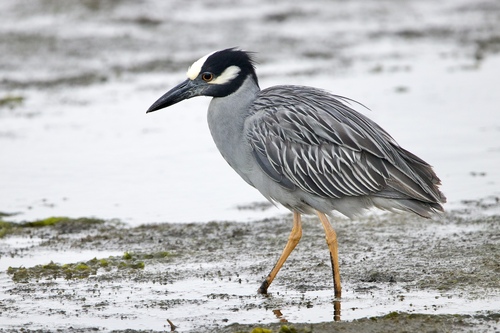
Yellow-crowned Night-heron
The Yellow-crowned Night-Heron (Nyctanassa violacea) is a stocky, medium-sized heron found in the Americas. It is distinguished from its close relative, the Black-crowned Night-Heron, by its yellow crown, white cheek patch, and overall grayer plumage. These birds are primarily nocturnal or crepuscular, specializing in hunting crustaceans, particularly crabs. They play an important ecological role in coastal and wetland ecosystems as predators of crabs and other invertebrates, helping to regulate their populations. While not globally threatened, they are vulnerable to habitat loss and degradation in many parts of their range.
55-70 cm
Length
90-110 cm
Wingspan
Least Concern
Conservation Status
Distribution
The Yellow-crowned Night-Heron is found along the coasts of North, Central, and South America, and on many Caribbean islands. Its range extends from the eastern and southern United States, south through Mexico and Central America, to coastal Peru and eastern Brazil. It is also present in the Galapagos Islands. They are generally non-migratory but some northern populations may move south in winter.
Lifespan
Up to 8 years in the wild has been recorded, though the average lifespan is likely shorter. Lifespan in captivity is not well documented.
Yellow-crowned Night-heron's Habitat
Habitat Types
Coastal marshes, Mangrove swamps, Estuaries, Lagoons, Rocky coastlines, Mudflats
Climate Zones
Tropical, Subtropical, Temperate
Adaptations
Their preference for coastal habitats and their ability to tolerate brackish water allow them to exploit a wide range of foraging opportunities. Their long legs and sharp bills are well-suited for wading and capturing prey in shallow water and mud.
Variations
Several subspecies are recognized, differing slightly in size and plumage coloration. These include *Nyctanassa violacea violacea* (eastern North America), *N. v. bancrofti* (Baja California and western Mexico), *N. v. caliginis* (Panama), *N. v. cayennensis* (northeastern South America), and *N. v. pauper* (Galapagos Islands).
Appearance
Breeding Plumage
Adult breeding plumage is characterized by a glossy black crown with a yellowish or creamy-white patch, white cheek stripes, and a gray body. Non-breeding adults have duller plumage. Juveniles are primarily brownish with streaking and spotting.
Seasonal Feather Changes
Plumage is most vibrant during the breeding season. The legs, typically yellow, can turn a brighter orange or coral-red during courtship.
Sex Based Plumage Differences
Males and females have similar plumage, although males may have slightly brighter colors during the breeding season.
Notable Features
Yellowish or creamy-white crown, White cheek patch, Long, thick, black bill, Red eyes (in adults), Relatively short, yellow legs (for a heron)
Diet and Feeding
Primary Foods
Crabs, Crayfish, Other crustaceans, Small fish, Insects, Snails, Leeches
Foraging Behavior
Yellow-crowned Night-Herons are primarily nocturnal and crepuscular feeders, often hunting at dawn and dusk, and throughout the night. They typically stand still or walk slowly in shallow water, waiting to ambush prey. They may also probe in mud or under rocks.
Specializations
Their strong, thick bill is well-adapted for crushing the exoskeletons of crabs and other crustaceans. They have excellent night vision, allowing them to forage effectively in low-light conditions.
Seasonal Diet Variations
Diet may vary slightly depending on prey availability. During periods of low crab abundance, they may consume more fish or insects. Inland populations rely more on crayfish than coastal populations.
Behavior
Social Structure
Yellow-crowned Night-Herons are generally solitary or found in pairs, especially during the breeding season. They may form loose colonies during nesting, and sometimes roost communally outside of the breeding season.
Communication
A loud, harsh 'squawk' or 'quark' call, often given in flight or when disturbed., Various croaking and clicking sounds during courtship., Bill-snapping as a threat display.
Migration
Most populations are non-migratory or only make short-distance movements. Northern populations may migrate south for the winter, moving to coastal areas with milder climates.
Territorial or Group Behaviors
During the breeding season, they defend nesting territories. Outside of the breeding season, they are less territorial but may defend feeding areas.
Conservation
Threats
Habitat loss and degradation (wetland drainage, coastal development), Pollution (pesticides, heavy metals), Human disturbance (at nesting sites), Climate change (sea-level rise, altered prey availability)
Protection Programs
Wetland restoration and protection initiatives., Monitoring of populations in some areas.
Local National Laws
Protected under the Migratory Bird Treaty Act in the United States.
Population Trend
Stable
Population Estimates
The global population is estimated to be between 180,000 and 1,200,000 individuals.
Interesting Facts
They are specialized crab hunters.
Their diet consists primarily of crustaceans, and they are particularly adept at catching and consuming crabs.
They can hunt during the day, but prefer night.
While primarily nocturnal, they can be active during the day, especially on cloudy days or in areas with dense cover.
Juveniles look very different from adults.
Young birds have brown and streaked plumage, providing camouflage in their wetland habitats.
They sometimes use bait to attract prey.
Although rare, they have been observed using small objects, like feathers or bread, as lures to attract fish.
Faqs about Yellow-crowned Night-heron
What is the difference between a Yellow-crowned Night-Heron and a Black-crowned Night-Heron?
Adult Yellow-crowned Night-Herons have a yellow crown and white cheek patch, while Black-crowned Night-Herons have a black crown and back. Juveniles are more difficult to distinguish, but Yellow-crowned Night-Heron juveniles tend to be darker brown and have thicker bills.
Where can I see a Yellow-crowned Night-Heron?
Look for them in coastal marshes, swamps, and mangroves along the Atlantic and Gulf coasts of the United States, and throughout the Caribbean and coastal areas of Central and South America.
Are Yellow-crowned Night-Herons endangered?
No, they are currently listed as a species of Least Concern by the IUCN. However, they are vulnerable to habitat loss and degradation.
Do Yellow-crowned Night-Herons migrate?
Most populations are non-migratory, but some northern populations may move south in winter.
What sound does a Yellow-crowned Night Heron make?
They make a loud, harsh 'squawk' or 'quark' call.
Copyright @ Nature Style Limited. All Rights Reserved.
 English
English